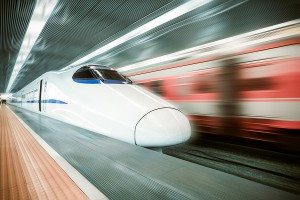 After a two-year delay, California officially marked the start of construction on what is meant to become the country’s first bullet train. The $68 billion project is hoped to eventually speed travelers between San Francisco and Los Angeles at 200 mph, cutting the trip down to less than three hours.
After a two-year delay, California officially marked the start of construction on what is meant to become the country’s first bullet train. The $68 billion project is hoped to eventually speed travelers between San Francisco and Los Angeles at 200 mph, cutting the trip down to less than three hours.
The project, however, remains clouded in uncertainty.
Work that began in early January involves the first 28-mile stretch of tracks from Fresno north to Madera. While the ultimate plan is to complete 520 miles of track, linking the Los Angeles Basin to San Francisco by 2029, funding and other issues continue to plague the project.
The Money Obstacle
The initial injection of money for the project came in 2008 when California voters agreed to a $10 billion bond to serve as seed money for the venture that will ultimately cost about seven times that amount.
Shortly after the bond measure was approved, the project was dealt a blow when estimates for construction rose and potential ridership estimates decreased.
In 2012, the federal government stepped in to help, dedicating $3.3 billion in stimulus funds to kick start initial construction. The California Legislature in 2014 also agreed to dedicate a portion of its greenhouse gas fees collected to fund the venture. Even so, a funding gap for the entire project remains.
State officials are banking on the possibility of private investment to keep the project chugging along on its full 500-plus-mile route. Other countries will bullet trains are able to generate revenue and it’s that carrot along with the potential for revenue from advertising and development around planned stations that is hoped to complete the financing package.
Missing Links
Funding isn’t the only obstacle California needs to overcome to complete its high-speed rail vision. Land is still needed to complete most of the route.
Only about 100 of the 500 land parcels required for the entire project have been secured as of yet. Critics contend many of those parcels are not contiguous, but the state so far hasn’t released the details to prove or disprove that contention.
While the project faces many obstacles, the groundbreaking on the first segment was viewed as a victory by supporters who say the train is a boon for the state and the environment.
The project has already created 632 jobs during the design and planning phase, and is expected to pull in a workforce of about 20,000 over the next five years
Gov. Jerry Brown sees the train as a major component in the state’s plan to increase dependence on renewable energy.
“It’s not that expensive,” he was quoted by Yahoo News as saying. “We can afford it. In fact, we cannot not afford it.”





